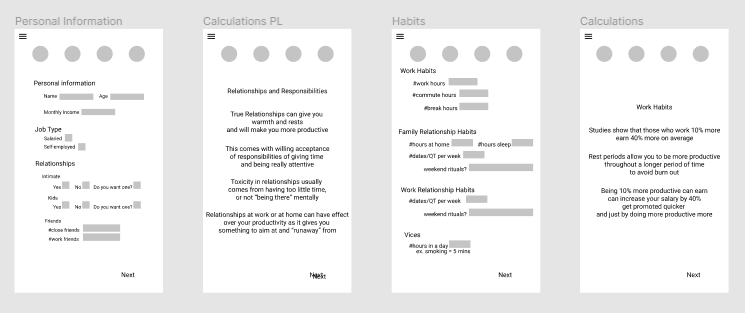Life Coin Project
- Timothy Medrano
- Dec 20, 2021
- 3 min read
Updated: Mar 9, 2022
Updated UI

Additional Screens

High Fidelity prototype:
https://www.figma.com/proto/IRj33mtFiaGN41JE1yWnVs/Life-Coin-2?node-id=102%3A221&scaling=scale-down&page-id=0%3A1&starting-point-node-id=102%3A221&show-proto-sidebar=1
Role: UX Research, UX-UI Design and Prototyping
Project Vision: Quantify qualitative aspects of our lives.
Challenges:
Research how to quantify good and bad habits in potential terms
Design UXUI to make it conducive for people to make entries and make self-accounting
Present data visually to users on how far they've come and how more they can improve
Research tools used:
Formulating personas, user stories and journey maps
Secondary psyche research materials and data
Personas:



User Journey Map:
Dave's example

Initial design where you will get it wrong:
The app will have to have two parts. The first is an initial information gathering and self-accounting with insights in between to help them along and to justify the computations within the app as well as the relationships between work and personal life when it comes to productivity.

The second part will soon to be the home and dashboard. It will include the input page, daily journaling, a graphical over view and a calendar view option.

Reiteration:
Most user found the first part of the app too cumbersome as it seems like a form they HAVE to fill up as opposed to it being conversational.
I used overlays in Figma to make the gathering of information part flowy. To ask for details one by one. The design challenge was how to make it seem coherent as if its still part of a "chapter" of self-accounting.

Lo-fidelity prototype:
A preview of basic functionality after an initial reiteration can be viewed here:
https://www.figma.com/proto/8lPtbCdZGRGvbmXRX1hHIK/Life-Coin-App?node-id=18%3A18&scaling=min-zoom&page-id=0%3A1&starting-point-node-id=18%3A18

Branding:
I wanted it to look "medical" and clean. This look takes away a sense of judgement and promotes objectiveness as the app proposes in acting on our own life.


*Updated UI


Summary:
Research how to quantify good and bad habits in potential terms
Design UXUI to make it conducive for people to make entries and make self-accounting
Present data visually to users on how far they've come and how more they can improve
Quantifying potential is always challenging and even rattling but it is important. The data is there, mostly by jumping off from Jordan Peterson's studies, Piaget, and Freudian concepts as well as empirical studies made in income and personality relationships. Two substantial personality traits that affect income is conscientiousness and agreeableness. Connecting this in simpler terms is computing daily rates coming from user input and dividing it as granular as number of hours. Each negative habits eg: smoking justifies an hour potential loss due to hospital expenses and productivity loss for each time one smokes a stick. Vice versa a good productive habit garners as much if not more benefits as it is learned that people who work 10% more earns 40% more due to being noticed by the superiors and peers as well as more productivity.
The next challenges is how to make it simple and concise enough so people do not feel like they're taking a psychological test or fulfilling a form. Part of that challenge is to shed the unnecessary fluff that only clinical psychologist might understand. Keeping it interactive and visual after inputs by using color schemes consistent and close to common schemes that signifies "negative" and "positive" and how they all connect together.
Take-aways:
Research, research, research. I was fortunate enough to have research these subjects personally before hand for a few years. The main challenge was to put quantitative data to intersect with qualitative data and to showcase it to users/people.
Self-accounting is hard and surprising that's why most people don't do it. Sometimes, ignorance is bliss but we cannot run from it. So simplifying the process without being judgemental and stick wagging like an old mentor is key. So, moving forward, this app may not be offered FREE. The price is not yet set but it should be set without being a premium item. It should be set to just filter out who really wants to do self accounting and not just trying it out.




Comments